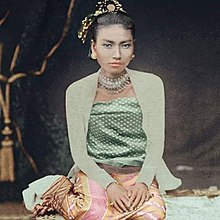| Supayalat စုဖုရားလတ် | |||||
|---|---|---|---|---|---|
 | |||||
| Chief queen consort of Burma | |||||
| Tenure | 12 April 1879 – 29 November 1885 | ||||
| Predecessor | Supayagyi | ||||
| Successor | disestablished | ||||
| Queen of the Northern Palace | |||||
| Tenure | 18 November 1878 – 12 April 1879 | ||||
| Predecessor | Thiri Maha Yadana Mingala Dewi | ||||
| Successor | none | ||||
| Princess of Myadaung, Tabayin and Manle | |||||
| Tenure | 1859 – 1878 | ||||
| Successor | disestablished | ||||
| Born | 13 December 1859 Mandalay, Burma | ||||
| Died | 24 November 1925 (aged 65) Rangoon, British Burma | ||||
| Burial | |||||
| Spouse | Thibaw | ||||
| Issue | 1 son, 4 daughters: Myat Phaya Gyi Myat Phaya Lat Myat Phaya Myat Phaya Galay | ||||
| |||||
| House | Konbaung | ||||
| Father | King Mindon | ||||
| Mother | Hsinbyumashin | ||||
| Religion | Theravada Buddhism | ||||
Supayalat (Burmese: စုဖုရားလတ်, pronounced [sṵpʰəjá laʔ]; 13 December 1859 – 24 November 1925), also spelt Suphayalat, was the last queen of Burma who reigned in Mandalay (1878–1885), born to King Mindon Min and Queen of Alenandaw (lit. 'Middle Palace'; also known as Hsinbyumashin or Lady of the White Elephant). The British corruption of her name was "Soup Plate".[1] She was married to her half-brother, Thibaw, who became the last king of the Konbaung dynasty in 1878, upon Mindon Min's death. She is best known for engineering a massacre of 80 to 100 royal family members, to prevent potential rivals from usurping Thibaw's power,[2] although she had always denied any knowledge of the plot, which may have been hatched by her mother together with some of the ministers, including the chancellor Kinwon Min Gyi U Kaung.[3][4]
King Thibaw was known for his reliance on Supayalat. Although Thibaw was king, many historians say it was Supayalat who actually ruled the country. The bloody coup that brought her and Thibaw to power associated her name with cruelty, brutality and barbarity. As a greatest achievement of Supayalat, she changed the royal tradition of polygamy to monogamy on a Burmese king for the first and the last time in history and never allowed Thibaw to take another woman as a consort.[3] Supayalat executed Daing Khin Khin, the secret concubine of King Thibaw, even though she was pregnant.[5]
In Burmese history, Supayalat is remembered for her ego, cruelty, and excessive pride, serving as the figure held responsible for the kingdom's fall into the hands of the imperialists. She became the embodiment of a Burmese proverb: "A woman can bring ruin to a kingdom" (မိန်းမဖျက် ပြည်ပျက်).[6]
- ^ Marshall, Andrew (2002). The Trouser People: A Story of Burma – In the Shadow of the Empire. p. 43. ISBN 1-58243-120-5.
- ^ Champeon, Kenneth (July 2003). "The Last Queen of Burma". The Irrawaddy. Retrieved 2006-12-08.
- ^ a b Khin Maung Soe (February 2007). "The Tragic Queen". The Irrawaddy. Retrieved 2007-02-05.
- ^ The Bandoola Journal (February 2007). "A Teatime Tete-à-Tete". The Irrawaddy. Retrieved 2007-02-05.
- ^ စုဖုရားလတ်ရှင်းတမ်းနှင့်ပါတော်မူဖြစ်ရပ်များ (in Burmese). Cui ̋cā pe. 2004.
- ^ "မိန်းမဖျက်လို့ပြည်ပျက်ရသတဲ့လား". MAWKUN Magazine. 9 February 2019.